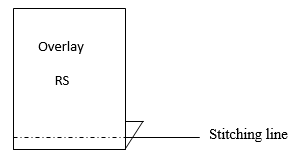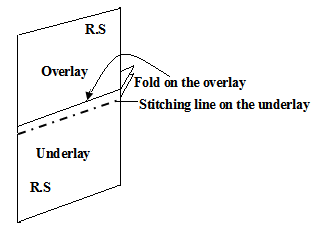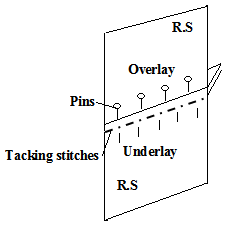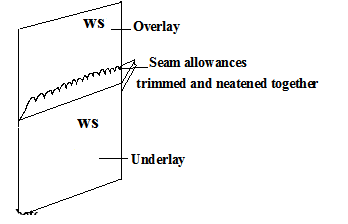QUESTIONS
SECTION A (40 MARKS)
Answer all the questions in this section
- Name the three major kitchen plans found in modern houses (3marks)
- Mention three ways of preventing young children from drowning (3marks)
- Serving equipments can be divided into five groups. List four of these groups (2marks)
- List four stitches used to hold edges in place (2marks)
- List six positions to consider when taking body measurements (3marks)
- State three nutrients which need a slight increase on a balanced diet of a lactating mother. (3marks)
- Suggest two remedies for garments that cling onto the body (2marks)
- Give three points on how to help a child learn and develop properly through play (3marks)
- Mention one similarity and one difference between osteo malaria and rickets (2marks)
- Identify two reasons for buying the fabric after drafting / buying a pattern (2marks)
- Suggest one laundry equipment that can be made using each of the following materials
- Galvanised iron (1mark)
- Cast iron (1mark)
- Outline two machine faults and their causes (2marks)
- Describe two problems a mother who has a ten month old body is likely to encounter when weaning her baby (2marks)
- Mention two advantages of breastfeeding and one limitation of breastfeeding (3marks)
- Define the following
- vaccine (1mark)
- antibody (1mark)
- What are two dangers of a mother delivering at home in the hands of traditional birth attendants (2marks)
- Mention four methods of removing dust from surfaces in a home (2marks)
SECTION B (20MKS) COMPULSORY
- You have been invited by your aunt for an evening party over the holidays
- Thoroughly clean your leather shoes ready for the party. (8marks)
- Dry clean your headgear with home dry cleaner (4marks)
- Clean an acrylic sweater (8marks)
SECTION C (40MKS)
Answer any two questions from this section
-
- Explain four (4) types of immunization given to children before their first birthday. (4marks)
- State and explain four factors that determine repair methods to be used on garments (8marks)
- Explain four points to bear in mind when serving meals for invalids (8marks)
-
- Explain three desirable qualities of well made tuck tuck (6marks)
- Mention six points to bear in mind when selecting play items (6marks)
- Using diagrams, describe how to make an overlaid seam (8marks)
-
- State four lifestyle diseases, their causes and remedies (8marks)
- Outline six qualities to look for when buying a sauce pan (6marks)
- Outline three points to consider when choosing fabric for nightwear. (6marks)
MARKING SCHEME
-
- Ushape kitchen plan
- L shape kitchen plan
- Onewall kitchen plan
- Corridor kitchen plan
-
- Water bodies around the compound, such as dams, swimming pools should be fenced.
- Children should not be allowed to swim alone
- Bathtubs should not be left unplugged
- Water containers e.g. buckets, drums should be covered
- Water taps should not be left running
-
- Measuring tools/ equipment
- Cutting equipment
- Marking equipment
- Pressing equipment
- Serving equipment
- Miscellaneous equipment
-
- Overcasting
- Loop stitching
- Herring stitches
- Hemming stitches
- Slip stitched hemming
- Whipping
- Decorative running stitches
-
- Waist
- Bust
- Nape
- Shoulder length
- Inner trouser length
- Chest width
- Hips
- Skirt length
- Outer arm length
- Crotch depth
-
- Fluids for milk production
- Calcium and phosphorous for teeth and bone development
- Iron to replace blood lost during delivery
-
- Rinsing the garments in water to which fabric conditioner her been added
- Wearing a under garment below it
-
- Allow for independence by encouraging a child to do things by itself.
- Providing plenty of room or space which enables a child to move about and discover things
- Parents and older children should take some time each day to play with small children
- Dressing the child in clothing which does not restrict playing
-
- Difference
- Rickets occur in children while ostemalacia occurs in adults
- Bones get deformed in rickets while bones get weak and fragile in oesteomalacia
- Similarity
- Both are caused by lack of Vitamin D, calcium and phosphorous in the body
-
- So that one may know the amount of fabric required
- So that one may know the type of fabric required and other serving notions
-
- Galvanised iron bricket, karais, cans, pails
- Cast iron - iron box (charcoal iron)
-
-
- Breaking of thread – incorrect insertion of needle
- Wrong threading, too tight tension
- Blunt needle, bent needle
- Needle breaking Needle bent, machining over pins, needle too fine for the work, needle not firmly fixed in place, fabric too thick for the needle
-
- Looping of stitches – incorrect threading
- Upper and lower tension too loose
-
- Puckering of the fabric – Needle too coarse for the fabric
- Stitches too long in case of very fine fabric
-
-
- The child may become malnourished, because the breast milk does not adequately cater for its nutritional requirements
- Its is more difficult to introduce new foods since the baby is accustomed to milk
-
- Advantages
- Breast milk contains all the necessary nutrients that are essential for the baby’s growth and development
- Breast milk is always at the right temperature. It does not need any warming
- Breast milk is clean and free from contamination
- Breast milk is available all the time since does not need to be purchased and the baby can have it on demand.
- Limitation
- Work conditions which may make the mother to be unavailable to breast feed the baby
- Health condition e.g. HIV if the mother is HIV positive may not breastfeed so as not to transmit the disease to the baby
- Define the following
- vaccine A preparation of weakened micro organisms/ either bacteria or viruses which when introduced into the body causes the body to produce antibodies
- antibody substances produced by the body after the introduction of a vaccine that protects the individual against the disease caused by the microorganisms which were used to produce the vaccine
-
- The mother may develop complication which a traditional birth attendant cannot handle at home
- The baby may be born with complication which require advanced attention not available at home.
-
- Sweeping
- Dusting
- Wiping
- Suction
-
-
- Cover ½ working area with newspapers
- Remove mud ½ if any with a blunt objects
- Dust ½ all over with a dry cloth
- Wipe inside ½ and outside ½ with a cloth wrung in warm soapy water ½
- Dry ½ with a dry duster / cloth ½
- Leave under shade ½ to dry
- Apply polish ½ using circular movement with a dry cloth / shoe brush
- Leave ½ for a while before shining
- Shine ½ using a dry brush / fluffy cloth ½
- Stuff ½ for storage
- Stone them ½ appropriately
- Clean and store ½ cleaning equipment / materials (16 x ½ = 8mks)
- Dry cleaning headgear
- Collect ½ all the cleaning equipment and materials
- Work in a well ventilated place ½ away from fire
- Immerse ½ the head gear in the liquid knead and squeeze ½ until clean
- Squeeze ½ out as much of the liquid as possible
- Dry ½ in an airy place
- Press ½ air ½ fold store
- Clean and store cleaning equipment and materials (8 x ½ = 4mks)
- Cleaning an acrylic sweater
- Collect ½ all of the materials to be used
- Mend appropriately when necessary ½
- Soak ½ in cold water for a short time if hearly soiled ½
- Wash ½ in warm detergent water ½ by kneading and squeezing ½ method
- Rinse thoroughly ½ in warm water ½ to remove dirt and soap them finally in cold ½ water to freshen the fabric
- A fabric conditioner may be added in the final rinsing water to prevent generation of static electricity in the fabric during use ½
- Drip dry in shade ½
- Finish by ironing ½ using a warm iron ½ on the W.S to avoid shiny marks ½
- Air ½ to dry completely
- Store appropriately ½ in a clean dry place, well folded ½ (16 x ½ = 18 mks)
-
-
-
- BCG vaccine given during 1st week of birth to protect against tuberculosis
- Oral polio vaccine (OPV) given to protect child against poliomyelitis – first dose given within the 1st 2 weeks
- Anti measles – vaccine given 9 months
- Diphtheria / tetanus/ hepatitis B haemophilis influenza type B expected to protect those diseases.
- 1st dose given after 6 weeks second dose after 10 weeks and the third after 14 weeks
- Size of the tear – for a large tear, a patch will be stronger than darn
- Weight of the fabric – darning would be more suitable on heavy fabrics than patching which would create bulky sections
- Method of fabric construction – knitted fabrics would best be darned while woven fabrics can take any method
- Cleaning method – items require friction method whem washing are best patched
- Effect desired – a decorrective patch may be used to create interest while a calico patch may be used where strength is needed
- Position of the tear – a tear on a collar would not be mended using same method as one next to a seam
- Type of garment / article – repair of an undergarment is done differently from an outer garment
(4 x 1 = 4mks)
-
- Meals should be balanced
- Meals should be served punctually
- Food should be prepared, cooked and served hygienically
- Food should be palatable and appetizing
- Food should be served attractively
- Give small amounts at a time
- Give hot foods hot and cold foods cold
- Food should be soft and easy to digest
- Avoid flavouring and smells in food (2 x 4 = 8mks)
-
-
- The tucks are made on straight grain of fabric for a good hang
- There is equal distance between one tuck and another which give balance
- Stitching lines are straight for beauty and neatness
- Each group of tucks are pressed towards one direction for uniformity
- The tucks are pressed flat at seam line to give a smooth finish
- The depth of each tuck is even throughout for neatness and flatness (2 x3 = 6mks)
-
- Easy to clean
- Big enough not to swallow
- Washable
- Strong and firmly fixed
- Unpainted
- Have no sharp edges
- Suitable to child’s age (1 x 6 = 6mks)
- Fold along the stitching line of the overlay to the W.S

- Work on R.S, by placing the fold in the overlay on the stitching line of the underlay

- Pin and tack close to the fold.

- Remove pins and machine close to the fold, remove tackings
- Trim seam allowances on the W.S
- Neaten the seam allowance together
- Press the seam flat

- Work on R.S, by placing the fold in the overlay on the stitching line of the underlay
- The tucks are made on straight grain of fabric for a good hang
-
-
- Diabetes – cause – body failure to control / regulate the level of glucose in the body due to habits like a lot of intake of sugars, carbohydrates and fats, lack of exercises, overweight etc
- Remedy – cut down on intake of sugars, junk foods and do exercises
- Gout – cause – high intake of red meat and alcohol
- Remedy – avoid excessive intake of red meat and alcohol
- Obesity – cause – overweight particularly on high intake of fats/ oils and caborhydrates
- Remedy – take a balanced diet
- Anorexia nervosa – cause – an eating disorder resulting from self starvation or lack of enough food
- Remedy – eat a well balance diet
- Eat all meals required
@ cause ½ x 4
@ stated disorder ½ x 4
@ remedy 1 x 4 (8mks)
-
- Base should be flat
- Should be well balanced
- Base should be thick to distribute heat evenly while cooking
- Should have a well fitting lid
- Should have a well fixed insulated handle
- General appearance should appealing to the eye (1 x 6 = 6mks)
-
- Should be light in weight for comfort
- Should be absorbent to absorb sweat for comfort
- Should be strong to withstand frequent washing
- Should be warm to keep one warm during cold night
- Should be soft not to irritate the skin
- (if a reason is not given, award zero) (3 x 2 = 6mks)
-
Download Home Science Paper 1 Questions and Answers - Form 3 End Term 3 2022 Exams.
Tap Here to Download for 50/-
Get on WhatsApp for 50/-
Why download?
- ✔ To read offline at any time.
- ✔ To Print at your convenience
- ✔ Share Easily with Friends / Students

